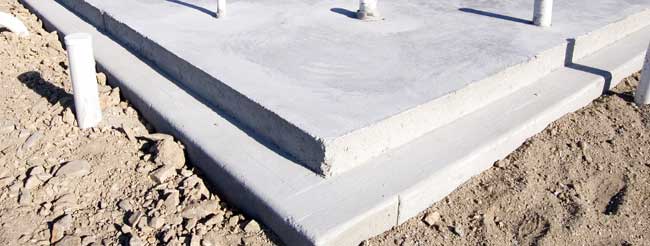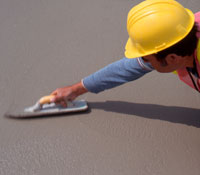Facilitating a Concrete Drying Schedule: Before and After the Slab Is Poured

Meeting concrete and flooring specifications can be a luxury that is not always available to the contractor on a tight schedule.
In flooring applications (either finished concrete or applied flooring), there is often that moment when it seems you can audibly hear the clock ticking away precious time as you watch the slab dry – wanting to move ahead but knowing that rushing too quickly may result in a flooring failure or flooring problem. While good curing conditions mean retaining an ideal initial moisture content, often a project schedule doesn’t allow the time necessary for optimal curing and drying.
What are the options?
 Before You Pour
Before You Pour
The best way to help speed the drying process is to find the right balance between initial mix water amounts and drying rates under job site conditions. However, that balance can be trickier than you think.
Reducing the amount of water in the concrete mix sounds like an obvious solution, but low water-cement ratio mixes typically have few capillaries (the natural pathways that allow water to move through the slab to the surface). Therefore, even with the initial mix water reduced, the actual result can still be slower drying time. For lightweight concrete in particular, aggregate must be saturated before mixing the concrete, so a certain level of water must be present. However, the more water that is present in the initial mix, the more water must evaporate out of the slab.
Using “Self-desiccation” agents in the concrete mixture is another option that contractors will turn to for improved drying time. Adding a higher ratio of cementitious material to the mix does bind more water into the paste of the concrete, but not without its price: the potential risk for cracking or shrinking in the finished slab is significantly higher. Other chemical admixtures, like silica fume, hydrate rapidly enough to permanently capture a percentage of the initial mix moisture and negating the extra drying time that volume of water would normally require. However, it should also be noted that these and other solutions typically have a higher cost involved that may outweigh the benefits.
Synthetic particles have also been tried as a substitute for lightweight aggregate. These synthetic substitutes are thought to reduce drying time in slabs because they do not absorb significant amounts of water that then need to be released.
 Additionally, of course, several mechanical factors also affect drying time. The first, of course, is how the slab is troweled. Hard troweling or slabs that are troweled to a burnished finish too quickly lose their ability to let moisture pass through. Those natural capillaries between the elements of the mix are, in effect, sealed off and drying time can be seriously impeded.
Additionally, of course, several mechanical factors also affect drying time. The first, of course, is how the slab is troweled. Hard troweling or slabs that are troweled to a burnished finish too quickly lose their ability to let moisture pass through. Those natural capillaries between the elements of the mix are, in effect, sealed off and drying time can be seriously impeded.
Vapor retarders are effective in reducing moisture from ground sources from entering the underside of the slab. Unfortunately, the initial effect on drying time can actually be slightly (although not always significantly) detrimental if it reduces another avenue for the moisture to escape the slab. This being said, for the long-term health of the building, a strong vapor retarder, directly under the slab, is necessary.
Post-Pour Solutions
Keeping preemptive steps in mind can do much to reduce the drying time for a newly-poured concrete slab. For a slab that has RH levels that are too high for installation, the options are slim. A moisture mitigation product can be utilized on the surface of the slab to “encapsulate” the slab’s moisture, allowing flooring installation to be completed. There are many products available that claim to accomplish this, so the specifier, installer, and/or contractor need to make sure they research each potential manufacturer and product.
 Really, the best strategy is to facilitate the slab’s natural drying process. Drying time ultimately depends on the balance of water and capillary structures in the concrete mix. Dehumidification tries to speed up the natural drying action.
Really, the best strategy is to facilitate the slab’s natural drying process. Drying time ultimately depends on the balance of water and capillary structures in the concrete mix. Dehumidification tries to speed up the natural drying action.
Dehumidification is one of the processes often used to try to encourage a concrete slab to dry more quickly in order to reach the required installation RH. The basic concept is simple: Reduce the dew point of the air surrounding the slab so that more of the latent moisture within the slab can evaporate out through the surface. In the building industry, there are several common approaches to dehumidification: condensation dehumidification, heating (or drying) dehumidification, and desiccant drying.
Desiccant-based dehumidifiers use a chemical attraction to remove moisture from the air. Humid air is moved across a desiccant material that binds and holds the moisture. A hot air stream is then used to release the moisture from the desiccant and vent it away from the slab’s environment. The dried desiccant then absorbs more moisture and releases it again through heating in a continuous process. In an enclosed structure, this process is not influenced by external weather, so it can be used year-round as long as the concrete slab can be isolated.
The condensation process uses cooling-based dehumidifiers which cool air, effectively dropping the dew point so that moisture can be collected and drawn away. By contrast, dehumidification uses heated air to raise the dew point of the surrounding air, allowing it to absorb more moisture from the slab surface. The saturated air is then circulated, either through a collection system, or to the outside air where it releases the excess moisture as it cools. It should be noted here that most installed HVAC systems are not capable of removing the amount of moisture emitted through the drying process of a concrete slab. While it may be possible to raise or lower the ambient temperatures through the HVAC system, dehumidification must actively remove the excess moisture from the structure. If the moisture is simply moved around within the walls, excess moisture can cause mold growth or equipment deterioration over time.
The real key to successful dehumidification is to have the concrete slab completely enclosed so that the moisture removed during the process is not re-introduced to the slab environment. Either the slab must be enclosed in service-ready indoor conditions, or a barrier must be erected around it for outdoor conditions.
Overall, the “natural” drying process of concrete takes time. Unfortunately, modern building schedules don’t usually allow the necessary time, so the need to have processes that help speed up drying and counteract excess moisture in order to allow successful flooring installation will continue to be necessary. However, with a combination of preemptive planning and post-pour decisions, the wait for the dry can be reduced significantly.